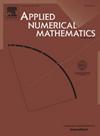High-order numerical solution for solving multi-dimensional Schrödinger-Poisson equation
IF 2.4
2区 数学
Q1 MATHEMATICS, APPLIED
引用次数: 0
Abstract
This paper explores the numerical solution of the Schrödinger-Poisson equation in one, two, and three dimensions, which has significant applications in quantum mechanics, cosmology, Bose-Einstein condensates, and nonlinear optics. To address the nonlinear aspects of the problem, we employ the split-step method, which decomposes the equation into linear and nonlinear components. The linear part is discretized using the compact finite difference (CFD) method, while the nonlinear component is solved exactly. For temporal discretization, we utilize the Crank-Nicolson method across all dimensions, achieving a second-order convergence rate of . Spatial discretization is carried out using a CFD scheme, ensuring a fourth-order convergence rate of . In the case of two- and three-dimensional Schrödinger equations, the alternating direction implicit (ADI) method is applied. We establish that the proposed numerical schemes are convergent, unconditionally stable, and maintain the conservation of mass and energy at the discrete level. Numerical experiments in one, two, and three dimensions validate the effectiveness of our approach. Specifically, we compare the split-step CFD scheme with alternative methods, and for higher-dimensional cases, we evaluate the ADI-split-step CFD scheme against the standard split-step CFD method. The results demonstrate that the proposed methods significantly reduce computational time while maintaining accuracy.
求解多维Schrödinger-Poisson方程的高阶数值解
本文探讨了一维、二维和三维Schrödinger-Poisson方程的数值解,该方程在量子力学、宇宙学、玻色-爱因斯坦凝聚和非线性光学中具有重要的应用。为了解决问题的非线性方面,我们采用了分步法,将方程分解为线性和非线性分量。采用紧凑有限差分(CFD)方法对线性部分进行离散,对非线性部分进行精确求解。对于时间离散化,我们在所有维度上使用Crank-Nicolson方法,实现O(τ2)的二阶收敛率。采用CFD格式进行空间离散化,保证四阶收敛速率为0 (h4)。在二维和三维Schrödinger方程的情况下,采用交替方向隐式(ADI)方法。我们证明了所提出的数值格式是收敛的,无条件稳定的,并且在离散水平上保持质量和能量的守恒。一维、二维和三维的数值实验验证了该方法的有效性。具体来说,我们将分步CFD方案与其他方法进行了比较,对于高维情况,我们将adi -分步CFD方案与标准分步CFD方法进行了比较。结果表明,该方法在保持精度的前提下显著减少了计算时间。
本文章由计算机程序翻译,如有差异,请以英文原文为准。
求助全文
约1分钟内获得全文
求助全文
来源期刊

Applied Numerical Mathematics
数学-应用数学
CiteScore
5.60
自引率
7.10%
发文量
225
审稿时长
7.2 months
期刊介绍:
The purpose of the journal is to provide a forum for the publication of high quality research and tutorial papers in computational mathematics. In addition to the traditional issues and problems in numerical analysis, the journal also publishes papers describing relevant applications in such fields as physics, fluid dynamics, engineering and other branches of applied science with a computational mathematics component. The journal strives to be flexible in the type of papers it publishes and their format. Equally desirable are:
(i) Full papers, which should be complete and relatively self-contained original contributions with an introduction that can be understood by the broad computational mathematics community. Both rigorous and heuristic styles are acceptable. Of particular interest are papers about new areas of research, in which other than strictly mathematical arguments may be important in establishing a basis for further developments.
(ii) Tutorial review papers, covering some of the important issues in Numerical Mathematics, Scientific Computing and their Applications. The journal will occasionally publish contributions which are larger than the usual format for regular papers.
(iii) Short notes, which present specific new results and techniques in a brief communication.
 求助内容:
求助内容: 应助结果提醒方式:
应助结果提醒方式:


